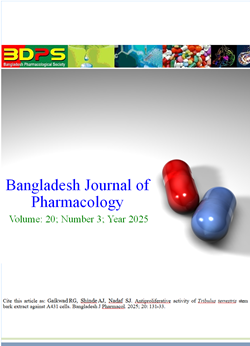Antiproliferative activity of Tribulus terrestris stem bark extract against A431 cells
DOI:
https://doi.org/10.3329/bjp.v20i3.83249Keywords:
Apoptosis, Antiproliferative, A431 cell, Tribulus terrestrisAbstract
Not available
Downloads
115
73
References
Abbas MW, Hussain M, Akhtar S, Ismail T, Qamar M, Shafiq Z, Esatbeyoglu T. Bioactive compounds, antioxidant, anti-inflammatory, anti-cancer, and toxicity assessment of Tribulus terrestris: In vitro and in vivo studies. Antioxidants 2022; 11: 1160.
Alshabi AM, Alkahtani SA, Shaikh IA, Orabi MA, Abdel-Wahab BA, Walbi IA, Habeeb MS, Khateeb MM, Shettar AK, Hoskeri JH. Tribulus terrestris cytotoxicity against breast cancer MCF-7 and lung cancer A549 cell lines is mediated via activation of apoptosis, caspase-3, DNA degradation, and suppressing Bcl-2 activity. Separations 2022; 9: 383.
Amanullah KZ, Zeenat F, Ahmad W, Firoz S, Naeela A. A comprehensive review on a Unani medicinal plant: Tribulus terrestris Linn. Int J Herb Med. 2021; 9: 23-28.
Bahuguna A, Khan I, Bajpai VK, Kang SC. MTT assay to evaluate the cytotoxic potential of a drug. Bangladesh J Pharmacol. 2017; 12: 115-18.
Chhatre S, Nesari T, Somani G, Kanchan D, Sathaye S. Phyto-pharmacological overview of Tribulus terrestris. Phcog Rev. 2014; 8: 45.
Dabaghkar Y, Eghlima G, Behboudi H, Ebrahimi M, Ghorban-pour M. Agro-morphological characterization and assess-ment of metabolic profiling and anticancer activities in various tribulus (Tribulus terrestris L.) populations. BMC Plant Biol. 2025; 25: 20.
Das N, Goshwami D, Hasan MS, Al Mahmud Z, Raihan SZ. Evaluation of antioxidant, antimicrobial and cytotoxic acti-vities of Terminalia citrina leaves. J Pharm Res. 2016; 10: 8-15.
Figueiredo CCM, Gomes AC, Granero FO, Bronzel Junior JL, Silva LP, Ruiz ALTG, da Silva RMG. Antiglycation and antitumoral activity of Tribulus terrestris dry extract. Avi-cenna J Phytomed. 2021; 11: 224-37.
Gaikwad R, Shinde A. Antiproliferative effect of Memecylon malabaricum leaves methanolic extract against A-431 cell lines. Bangladesh J Pharmacol. 2022; 17: 54-55.
Gaikwad RG, Shinde AJ, Hajare AA. Herbal treatment for management of psoriasis: An overview. RJPT. 2022; 15: 1385-92.
Johnston JB, Navaratnam S, Pitz MW, Maniate JM, Wiechec E, Baust H, Gingerich J, Skliris GP, Murphy LC, Los M. Targeting the EGFR pathway for cancer therapy. Curr Med Chem. 2006; 13: 3483-92.
Neychev VK, Nikolova E, Zhelev N, Mitev VI. Saponins from Tribulus terrestris L. are less toxic for normal human fibroblasts than for many cancer lines: Influence on apoptosis and proliferation. EBM. 2007; 232: 126-33.
Pourali M, Yaghoobi MM, Sormaghi MH. Cytotoxic, anti-proliferative and apoptotic effects of Tribulus terrestris L. fruit extract on human prostate cancer Lncap and colon cancer HT-29 Cell Lines. Jundishapur J Nat Pharm Prod. 2017; 1; 12: e33561.
Zheng L, He H, Shen X, Sun Y. Centipede scolopendra suppresses cell growth in human epidermoid carcinoma cell A431. Bangladesh J Pharmacol. 2017; 12: 299-307.

Downloads
Published
How to Cite
Issue
Section
License
Copyright (c) 2025 Ravindra Gaikwad, Anilkumar Shinde, Sameer Nadaf

This work is licensed under a Creative Commons Attribution 4.0 International License.
Authors who publish with this journal agree to the following terms:
- Authors retain copyright and grant the journal right of first publication with the work simultaneously licensed under a Creative Commons Attribution License that allows others to share the work with an acknowledgement of the work's authorship and initial publication in this journal.
- Authors are able to enter into separate, additional contractual arrangements for the non-exclusive distribution of the journal's published version of the work (e.g., post it to an institutional repository or publish it in a book), with an acknowledgement of its initial publication in this journal.
- Authors are permitted and encouraged to post their work online (e.g., in institutional repositories or on their website) prior to and during the submission process, as it can lead to productive exchanges, as well as earlier and greater citation of published work (See The Effect of Open Access).
